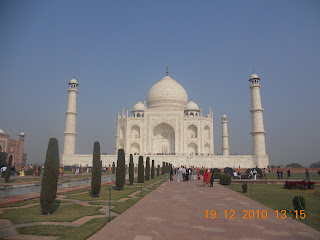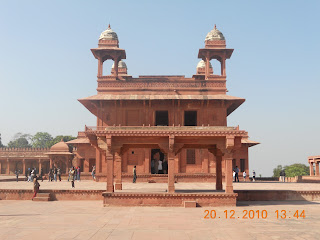December 2010
The towering archway of India Gate, a war memorial
We took an 8D/7N tour of New Delhi, Agra and Jaipur sometime in December 2010 through AirAsiaGo and I would say that we got a fantastically good deal.
Our first stop in New Delhi is Jama Masjid which incidentally is the largest mosque in India.
Jama Masjid, the largest mosque in India.
Leave your shoes outside and step in
Within the walled compound, the courtyard is large enough to hold an incredible 25,000 devotees. Sad to say, I cannot post any pictures of the courtyard for photography was not allowed when we visited; so, I can only post the exterior pictures. Dress appropriately when visiting the mosque; for ladies this means covering the head, legs and shoulders.
Jama Masjid
We moved on to have a look at India Gate, which was built in memory of the fallen Indian soldiers fighting for the British Army in World War I.
India Gate seen from across a park
Next was Qutub Minar (The Qutub Tower; Urdu: قطب مینار), constructed with red sandstone and marble, and is the tallest minaret in India.
72.5
meters, 379 stairs to the top
Intricate
carvings on the wall of tower
This early Indo–Islamic architecture has five distinct stories and was built in 1206. It is surrounded by several other ancient and medieval structures and ruins.
Surrounding structures and ruins
Unfinished structure with old well at foreground
According to our tourist guide there was also another attempt to build a similar tower, but it was not successful; only the weathered-worn base was left.
Tomb of Imam Zamin
On our way to Agra, we were driving behind this lorry which exhorts one to "Horn Please"; this is common in India. Interesting, because I have never seen this sign behind any of our Malaysian sports lorrries before; maybe that's why we dare not horn any lorry here for fear we may anger the F1-wannabe drivers. You won't want to imagine how they may respond behind the safety of their big, monstrous weapons lorries.
"Horn Please" .. is this the reason for the noisy roads?
Agra
Needless to say, one comes to Agra to specifically visit the Taj
Mahal (Hindi: ताज महल; Persian/Urdu: تاج محل "crown of
palaces"), a white marbled mausoleum built by the grief-stricken Mughal
emperor Shah Jahan in memory of his third wife, Mumtaz Mahal who died during the birth of their 14th child.
Visiting the Taj Mahal is a compulsory pilgrimage for the die-hard romanticist at heart.
The Great gate
(Darwaza-i rauza)
- gateway to the Taj Mahal
The Taj Mahal, framed by the gateway
The spectacular and timeless monument to love
A closer view
To protect the monument
To protect the unimitable and vulnerable marble monument from damage, everyone is required to cover up their shoes with a cloth-like covering.
Taj Mahal mosque
View of Taj Mahal from the mosque
The Taj Mahal is symmetrical on all four sides, which means whether one looks from North, South, East or West of the structure, the facade is the same.
Next stop is the Fatehpur Sikri, but as tours are concerned, it is expected that the itinerary must also include some compulsory stops at tourist souvenir centers; again as I understood from my tour guide, this is to help stimulate the local economy (at our expense?)
A marble inlay table top factory in Agra
We stopped at a marble inlay table top factory where we see hand made marble table tops being inlaid with semi precious stones like malachite, mother of pearl, lapis lazuli, agnate, italian stones, and so forth. Admittedly, the handiworks are beautiful and the quality very high; and so too is the price of each item. As I won't bet on my bargaining skills (acquired in the course of playing marbles in my childhood days; is it good enough?) against that of the glib-speaking, professional
Our next stop: Fatehpur Sikri (Hindi:
फ़तेहपुर सीकरी, Urdu: فتحپور سیکری) is a city and was built
during the 16th century, and is one of the best preserved
collection of Mughal architecture in India. We did not explore the whole city; our tour was limited to the Fatehpur Sikri Palace. Here are some pictures we managed to capture in the short time spent there:
The road to the palace
Diwan-i-Khas (Hall of Private Audience)
The
four structures on roof are called chhatris
It is at
the Diwan-i-Khas that Akbar gave private audience and had representatives of
different religions discuss their faiths.
The central pillar of Diwan-i-khas
Panch Mahal, a five-storied palatial structure.
The Anup talao is an ornamental pool with a central platform and four bridges leading up to it; the platform was used for singing competitions.
Mariam-uz-Zamani House
Mariam Zamani Palace
Mariam Zamani is the third wife and one of his three chief queens.
Entrance to Queen's Palace
Don't miss this place when you are in Agra.
( ... to be continued ...)
( ... to be continued ...)






























No comments:
Post a Comment